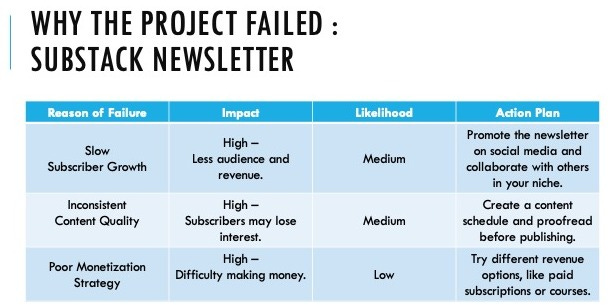It’s was total disaster
Picture this. 📸
Your highly skilled team has invested months of hard work into a project, only to see it crumble at the end.
Deadlines were missed, budgets were blown, and team morale is at an all-time low.
What went wrong?
You had a plan - a good plan even endorsed by senior management - but it wasn’t enough to save you from the unforeseen obstacles that brought everything crashing down.
In the aftermath, you gather your team for a post-mortem. The team arrives with their notebooks, computers, and Starbuck coffee. ☕
Together, you dissect every single detail, uncovering the mistakes, miscommunications, and overlooked risks.
You document all the key learnings, and each team member vows never to repeat these errors again! Satisfied, the team quickly disperses, never to talk about this fiasco again.
Seem familiar?
Fail before you fail : The Pre-Mortem approach
While post-mortems are valuable for analyzing what went wrong after a project has failed, a pre-mortem offers a proactive approach.
A pre-mortem is a planning exercise conducted before a project starts to help anticipate and address potential setbacks.
Essentially, even before launching the project, you first project yourself into the future and assume it has been a total fiasco.
The worse the imagined outcome, the better!
This shift in perspective allows you to examine potential pitfalls with a fresh outlook, uncovering hidden risks and weaknesses that might not be apparent during traditional planning.
A pre-mortem exercise helps you therefore play detective before proceeding, thereby helping you can address issues before they become real problems.
The benefits are clear :
Proactive Problem-Solving: Pre-mortems help anticipate issues and develop strategies to prevent them.
Enhanced Risk Management: This approach can reveal overlooked risks and enable better planning.
Improved Team Collaboration: It fosters a collaborative environment where team members contribute to identifying potential pitfalls.
How to save your project
🚀 It’s really not rocket-science.
Performing a pre-mortem is fairly straight-forward, follow these 5 steps :
❇️ Assemble the Team: Gather your team and present the project plan. Ensure everyone understands the goals and scope of the project.
❇️ Imagine the Failure: Visualize a future where the project has failed. Ask the team to identify what could have gone wrong and the key reasons for the failure. Brainstorm potential issues and risks that could lead to this failure. The more detailed and extensive the brainstorming, the better.
❇️ Look for Patterns: Analyze the brainstormed issues to identify recurring themes or patterns. Are there common risks or weaknesses that appear frequently? Recognizing these patterns helps prioritize which risks to address first and refine strategies accordingly.
❇️ Mitigate Risks: Document the identified risks and develop strategies to mitigate them. This might include contingency plans, more resources, or adjustments to the original project plan.
❇️ Review and Keep Refining: Refine the project plan based on the pre-mortem findings to ensure you are better prepared for potential challenges as they arise.
Take-home message:
A pre-mortem helps you play detective before the fact, providing an opportunity to refine your strategy and mitigate risks before they impact your project's success.
Assume it was a fiasco, and mitigate the risks.
Now back to my Starbucks coffee. ☕
If you enjoyed this article,
show your support by subscribing, no pre-mortem required 😀
About the Author:
Nick is passionate about enabling people and businesses to reach their full potential.
He taps into over 25+ years of truly diverse leadership experience, challenging the status quo - to ultimately define a clear strategic path forward and propel success.
Thought Leader | Board member | Founder of Aktina Group Consulting | Proud Father






